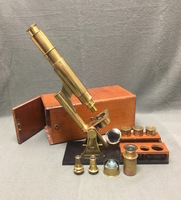Items
Description is exactly
This microscope is a rare example as it has a cast iron base which appears to have been purpose-built rather than retrofitted. The actual instrument has been stripped of its gunmetal and black lacquers. The microscope is signed with a stamped with "Smith & Beck, London" on the side pillar. The cast iron base is attached to the dual side pillars which end in trunnions that allow for inclination. The square stage has a substage iris diaphragm which can be removed and a substage plano-concave mirror set in a gimbal. Coarse focusing is achieved by sliding the body-tube through the cylinder attachment connected to the main pillar. The fine focusing is controlled by knurled knob at the base of the pillar and the cast iron base is attached to a mahogany accessories tray that holds the objective and objective lens. The mahogany case is secured by a lock and key, which is broken. The base slides into the case horizontally. The microscope design was low end and became eclipsed by the binocular version — "Popular Microscope" — by 1865. The instrument was described by Richard Beck in his book, A Treatise, in 1865 and reviewed by Gerald Turner in his book, The Great Age of the Microscope (1989).

